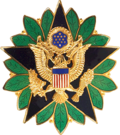This article needs additional citations for verification .(April 2025) |
| Chief Warrant Officer of the Army | |
|---|---|
 | |
| Department of the Army | |
| Reports to | Chief of Staff of the Army |
| Formation | March 2014 |
| First holder | David Williams |
The Chief Warrant Officer of the Army (CWA) is the most senior warrant officer position in the United States Department of the Army and serves as a key advisor within the Office of the Chief of Staff of the Army. The role involves providing expert counsel on matters related to warrant officer management, training, education, and policies, while also supporting broader Army strategic goals.
Contents
The post was announced by CSA GEN Raymond T. Odierno on March 14, 2014, wherein CW5 David Williams was established as the first ARSTAF SWO. [1] Since 2014, the Department of the Army has maintained a senior warrant officer position with various titles, such as Army Staff Senior Warrant Officer (ARSTAFF SWO) and Senior Warrant Officer Advisor to the Chief of Staff of the United States Army (SWOA2CSA). On July 10, 2024, this role was officially named the Chief Warrant Officer of the Army (CWA), solidifying its importance as the highest-ranking warrant officer role in the Army and an integral member of the Office of the Chief of Staff of the Army.
The Chief Warrant Officer of the Army’s duties include advising principal officials on issues related to talent management, training, education, doctrine, policies, quality of life, and other Army matters, with a focus on the needs and development of warrant officers. Additionally, the CWA chairs the Army Warrant Officer Council (ARWOC) and works collaboratively with Army staff, agencies, and personnel to support and advance the Army's strategic initiatives.





